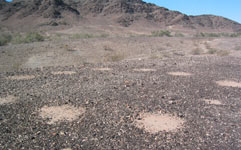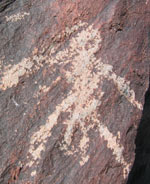Mule Canyon & Mule Tank
Petroglyphs

If
you love petroglyph sites as much as we do, then this trip
is for you! Both locations are on the north side of Mule
Mountain, southwest of Blythe. For excellent directions
to this site, and many others, we'd recommend David Whitley's
book A Guide to Rock Art Sites - Southern California and
Southern Nevada. Of course in addition to directions
he gives a thorough discussion of the rock art and includes
some nice color photos. The drive to these sites involves
some sandy washes to the first location, and then eroded and
rocky conditions to the second. Four wheel drive would
be nice to have. It's a long walk if you get stuck.
 The
Mule Canyon site is a pebble terrace that has two converging
aboriginal trails crossing it. Where these trails join,
and along them, are dance circles and other unexplained designs. There
are BLM interpretive panels which help to orient you to the
location of these and their possible significance. We
did find a piece of pottery in the wash and photographed it
in place as well as removing it briefly for a better shot. However,
it was then replaced exactly where we found it. It's
interesting to conjecture what was going on here in the distant
past. Obviously these trails came from the Colorado River,
and the trail that continues on to Mule Tank can still be seen
in spots. Apparently it continues on to Corn Springs,
a year round water source. The reason the trail passes
here is likely due to Mule Tank, the location of some remarkable
petroglyphs!
The
Mule Canyon site is a pebble terrace that has two converging
aboriginal trails crossing it. Where these trails join,
and along them, are dance circles and other unexplained designs. There
are BLM interpretive panels which help to orient you to the
location of these and their possible significance. We
did find a piece of pottery in the wash and photographed it
in place as well as removing it briefly for a better shot. However,
it was then replaced exactly where we found it. It's
interesting to conjecture what was going on here in the distant
past. Obviously these trails came from the Colorado River,
and the trail that continues on to Mule Tank can still be seen
in spots. Apparently it continues on to Corn Springs,
a year round water source. The reason the trail passes
here is likely due to Mule Tank, the location of some remarkable
petroglyphs!Mule
Tank itself is a deep depression at the head of a narrow,
winding wash. It is fed by a waterfall with a drop of
over twenty feet that must really be a sight when it's
raining. The water trapped in the tank was appreciated
by animals and humans alike. The trail came by here because
it provides the only seasonal water source in the immediate
area. It would be a logical resting place on the trek
to Corn Springs. There is another BLM interpretive panel
at the mouth of the wash. You begin your adventure  here
by hiking up the wash. The petroglyphs are everywhere
on both sides. We were there in the early spring, and
were amazed to find one of the bushes in the wash completely
covered by butterflies. We did some scrambling up the
west side of the wash to get a closer look at the numerous
petroglyph panels. The prized gem of this location eluded
us for quite a while. This rare depiction is a female
shaman. Most shamans are male, but a remarkable woman
broke into the good ol' boy club and got memorialized here. We
finally spotted her figure, identified by the rather prominent hanging
labia, high on the west wall. While photographing her
I looked over to where Niki was and noticed something in a
rock cave down near her feet. It turned out to be a geocache. We've
found several while out looking for them, but this was the
first one we've found without even knowing it was there! From
there we dropped down into the tank. It's capable of
holding a tremendous amount of water, and would be a welcome
sight to Indian travelers. Their reverence for this site
is certainly clearly displayed by the profusion of rock art. On
our way back down the wash we ran across a juvenile chuckwalla
out for a stroll.
here
by hiking up the wash. The petroglyphs are everywhere
on both sides. We were there in the early spring, and
were amazed to find one of the bushes in the wash completely
covered by butterflies. We did some scrambling up the
west side of the wash to get a closer look at the numerous
petroglyph panels. The prized gem of this location eluded
us for quite a while. This rare depiction is a female
shaman. Most shamans are male, but a remarkable woman
broke into the good ol' boy club and got memorialized here. We
finally spotted her figure, identified by the rather prominent hanging
labia, high on the west wall. While photographing her
I looked over to where Niki was and noticed something in a
rock cave down near her feet. It turned out to be a geocache. We've
found several while out looking for them, but this was the
first one we've found without even knowing it was there! From
there we dropped down into the tank. It's capable of
holding a tremendous amount of water, and would be a welcome
sight to Indian travelers. Their reverence for this site
is certainly clearly displayed by the profusion of rock art. On
our way back down the wash we ran across a juvenile chuckwalla
out for a stroll.
 here
by hiking up the wash. The petroglyphs are everywhere
on both sides. We were there in the early spring, and
were amazed to find one of the bushes in the wash completely
covered by butterflies. We did some scrambling up the
west side of the wash to get a closer look at the numerous
petroglyph panels. The prized gem of this location eluded
us for quite a while. This rare depiction is a female
shaman. Most shamans are male, but a remarkable woman
broke into the good ol' boy club and got memorialized here. We
finally spotted her figure, identified by the rather prominent hanging
labia, high on the west wall. While photographing her
I looked over to where Niki was and noticed something in a
rock cave down near her feet. It turned out to be a geocache. We've
found several while out looking for them, but this was the
first one we've found without even knowing it was there! From
there we dropped down into the tank. It's capable of
holding a tremendous amount of water, and would be a welcome
sight to Indian travelers. Their reverence for this site
is certainly clearly displayed by the profusion of rock art. On
our way back down the wash we ran across a juvenile chuckwalla
out for a stroll.
here
by hiking up the wash. The petroglyphs are everywhere
on both sides. We were there in the early spring, and
were amazed to find one of the bushes in the wash completely
covered by butterflies. We did some scrambling up the
west side of the wash to get a closer look at the numerous
petroglyph panels. The prized gem of this location eluded
us for quite a while. This rare depiction is a female
shaman. Most shamans are male, but a remarkable woman
broke into the good ol' boy club and got memorialized here. We
finally spotted her figure, identified by the rather prominent hanging
labia, high on the west wall. While photographing her
I looked over to where Niki was and noticed something in a
rock cave down near her feet. It turned out to be a geocache. We've
found several while out looking for them, but this was the
first one we've found without even knowing it was there! From
there we dropped down into the tank. It's capable of
holding a tremendous amount of water, and would be a welcome
sight to Indian travelers. Their reverence for this site
is certainly clearly displayed by the profusion of rock art. On
our way back down the wash we ran across a juvenile chuckwalla
out for a stroll.Enjoy
the pictures below, but it's a lot better in person!
